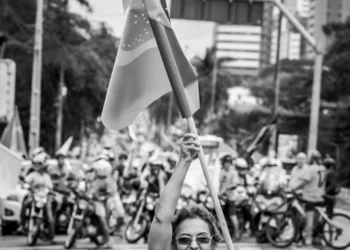by Helena Vetorazo*
Reviewed by Matheus Lucas Hebling
Special Edition – Women of Brazils: “Girl’s Feminism – networks of Power and Coping”
The Special Edition (SE) No. 6 on the Women of Brazils closes its cycle today with the publication of Dr. Helena Vetorazo’s text about feminism, high school, and spring secondary in Brazil. Enjoy the reading!
Claudia Pires de Castro and Helena Vetorazo
Introduction
This article aims to present the performance of girls, high school students in public and private institutions, and self-declared feminists, in virtual social networks and physics networks. The participant observation carried out in virtual social networks and the physical spaces frequented by students, in the period from 2017 to 2021, showed that girls are mobilized in groups, pages, and communities of virtual social networks and physical spaces, creating and sharing content aimed at transforming gender relations, in and out of school.
In addition to the Introduction, the article is organized into three parts. The first part contextualizes the actions of girls in the secondary student movement, called The Secondary Spring; the second part shows the girls’ actions on social networks; the third part presents some considerations.
Fight seeds
In mid-2015, São Paulo students started a movement to occupy public schools in protest of the project to restructure the state school system. Generally speaking, the restructuring consisted of relocating students, especially high school ones, to fight the closure of several teaching units in the state of São Paulo to centralize students in schools appointed by teaching leaders, without considering the places of work and housing of students. The strong pressure from students across the state led the government to repeal the project, ending student actions in the state. The following year the movement spread throughout different Brazilian states with diversified agendas and became known as Secondary Spring (Rocha, 2020; Coast; Heifer, 2019; Hollanda, 2018).
A common feature of the “Spring Secondary” in the different Brazilian states was the use of social networks, to show the day-to-day occupations and the strong presence of girls in activities inside and outside schools. Followed by the hashtag “fight like a girl” (#lutecomoumamenina) and “mines of struggle” (#minasdeluta) the images showed the girls on the front line of the organization of living spaces in schools and street demonstrations, often in confrontation with police forces.
According to Marusco (2022), the movement was guided by the ethics of coexistence proper to feminist struggles. The researcher considers that “as a consequence of this coexistence based on feminist expressions, it was possible to resist also feminist, evidencing the political, pedagogical and collective power of girls/women and LGBTI+ people” (Marusco, 2022, p. 2). According to Hollanda (2018), this experience of coexistence radicalizes the “potential of collaboration and affective exchanges”, echoing the “Feminist Spring” led by girls who, from the conviviality in schools and social media groups, raised different agendas related to fundamental rights and gender relations inside and outside schools (Hollanda, 2018, p.38).
With the end of the occupations, the young high school students continued to organize themselves in feminist groups created on different digital platforms – Facebook pages, Youtube channels, Twitter accounts, and Instagram profiles – to discuss topics such as gender diversity, abortion rights, sexual harassment, racism, machismo and, especially, the right to education as one of the central elements for the construction of social transformation.
Girls in Action
After more than five years, the high school students of a public school in the interior of São Paulo, continue to share the contents published by the girls of the high-school movement in virtual social networks. A 16-year-old student says: “The images of the occupation are in the networks and continue to motivate us and teach us that a girl can and should fight for rights.” The student follows groups created by different feminist collectives on virtual social networks and usually shares TBTs (Throwback Thursday) and hashtags with expressions that, according to her, are important to “keep the girls’ fight alive”. The hashtag has asserted itself as a form of political participation in virtual social networks to articulate people of similar interests around a subject (Burgess, 2012; Hughes & Palen, 2009). It was from these interactions that the young woman set up a group with students from public schools and private schools, to discuss, in virtual spaces and also in physical spaces, topics such as teenage pregnancy, abortion, violence against women, and machismo.
A 17-year-old private school student says she met the group through a friend who tagged her Facebook profile with the hashtag #minasdeluta (#minasdeluta). According to the young woman, the girls who participated in the occupations “left a feminist lesson that all girls have power.” In addition to participating in activities in virtual social networks, the young woman performs, with other girls, conversation wheels in schools to talk to boys, girls, teachers, and teachers about the meaning of feminism and its importance for the construction of equality in gender relations.
Boys are also invited to join the group. A 17-year-old student said that “The world needs feminist men to overcome the toxic masculinities that prevent men from respecting women.” The girls who work in the coordination of the group defend the idea that it is necessary to disseminate feminist ideas to all people. The young woman responsible for creating the group points out: “There is a sexist woman, there is a macho man and I think feminism should reach everyone and social networks are good for this.”
According to the coordinators, Chimamanda Ngozi Adichie’s book, We Should All Be Feminists, is one of the mandatory readings for everyone and everyone who expresses interest in engaging in the group’s activities. They consider that to participate in the conversation wheels in schools the participants of the group must have a “good knowledge” about what they will approach so that, without realizing it, they reproduce values and prejudices present in the everyday life.
In virtual social networks, in addition to hashtags, girls share memes, called “anti-sexist” that is produced from experiences lived by them and by them in day-to-day interactions. According to Calixto (2017), the meme is a micronarrative loaded with ideas and discourses that circulate in society. Because of their power to synthesize information in a combination of images and texts, memes are used to meet diverse goals that vary, from the spread of hate speech to the contestation of belief systems and exclusionary values. For them, memes are a tool for coping with gender violence that happens in their journeys on the Internet, at school, and in other physical spaces.
Girls’ feminism has been configured as a political field in which virtual social networks are the central tool for promoting the understanding and popularization of feminism and articulation with other feminist fields.
Some Considerations
The Secondary Spring brought seeds that germinated and begin to bear fruit. Although the achievements in the educational area are not enough, the students perceived the collective power to build more egalitarian gender relations.
In the use of virtual social networks, the young women found a way to guide the struggle of girls inside and outside school, bringing to light situations of machismo and exclusion that permeate their daily interactions. Through hashtags and memes, young women develop creative protests and ensure the visibility of girls’ feminism, as an integrating and intersectional field that seeks to transgress, include and transform relationships in the spaces frequented by youth.
References
BURGESS, J. The iPhone moment, the Apple brand, and the creative consumer: From ‘hackability and usability’ to cultural generativity. In L. Hjorth, I. Richardson, & J. Burgess (Eds.), Studying mobile media: Cultural technologies, mobile communication, and the iPhone (pp. 28–42). London: Routledge, 2012.
CALIXTO, D. Memes na internet: entrelaçamentos entre educomunicação, cibercultura e a ‘zoeira’ de estudantes nas redes sociais. 2017. 151f. Dissertação de Mestrado. Área Interfaces Sociais na Comunicação. Escola de Comunicação e Artes, Universidade de São Paulo, São Paulo
CASTELLS, M. Redes de Indignação e Esperança. Movimentos sociais na era da Internet. Rio de Janeiro: Zahar, 2013.
COSTA, C.L; BEZERRA, M.C. dos S. O movimento Primavera Secundarista no Contexto do Neoliberalismo: Algumas Considerações. Revista Expedições, Morrinhos/GO, v.10, num.3m set/dez/2019. Disponível em https//www.revista.veg.br acesso em 10/janeiro/2022.
DURKHEIM, E. Educação e sociologia. São Paulo: Melhoramentos, 1952.
HUGHES, A., & PALEN, L. Twitter adoption and use in mass convergence and emergency events. International Journal of Emergency Management, 6(3–4), 248–260, 2009.
MORESCO, M.C. Primavera secundarista: uma convivência feminista. Revista Estudos Feministas, v. 30, 2022 30(1), 2022. 30(1), 2022.
ROCHA, D.L da. Ocupação das escolas 2015 e 2016: uma breve análise da forma e do conteúdo da ação dos estudantes. Revista Sociologias Plurais, v. 6, num.1, p.61-86, jan.2020.
Helena Vetorazo received a PhD in Social Sciences in Education at the University of Campinas (UNICAMP), a master in Social Sciences from the same university and a bachelor’s degree in Social Sciences from the University of São Paulo (USP) with specializations in Ethics (USP-UniVesp); in History, Culture and Society (PUC-SP); member of the Research Group on Sociocultural Differentiation (Unicamp); member of the Brazilian Association for the Teaching of Social Sciences (ABECS) and Member of BRaS Research Group Social Media Studies.
Vetorazo, Helena. 2023. "Girl’s Feminism – networks of Power and Coping". Brazilian Research and Studies Blog. ISSN 2701-4924. Vol. 4 Num. 3. Available at: https://www.bras-center.com/girls-feminism-networks-of-power-and-coping/, accessed on: July 8, 2025.









